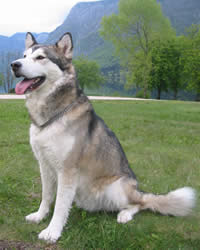Alaskan Malamute Dog Breed Information
 |
| ||||||||||||||||||||||||||||||||||||||||||||||||||||||||||||||||||||||||||||||||
Alaskan Malamute – Just The Facts
| Do you own this Dog breed?Please tell us about it in the form at the bottom of this page. |
General Description
Their wolfish appearance might make you uneasy at first, but the Alaskan Malamute doesn’t really make the cut for watchdog material. They are rather friendly and playful creatures who enjoy frolicking in the snow. For the cold-loving, outgoing pet owner, there’s no doubt that this dog breed will make a fine family addition.
Origin and History
Alaska is obviously the home of this handsomely coated breed, but the origin and history of the name is familiar to those who have studied the Innuit tribe that frequented the region. This working dog breed used to live with the “Mahle” people in their “mut” or village.
The Alaskan Malamute’s size and strength made them ideal haulers, sled pullers and big-game hunting companions. Today, they double as family companions but will gladly pick a fight with other dogs.
Alaskan Malamute Temperament
If there’s one thing you need to brace for with this large dog breed, it’s animal aggression. Though known to work in packs, the Alaskan Malamute has hunting instincts which can very well place pets, small animals and same-sex canines at risk.
The breed can also be strong-willed and will readily boss you around. For this reason, they are better suited for the veteran pet owner.
Care, Grooming, Diet & Exercise
Living Environment – You should think twice about raising an Alaskan Malamute if you live in the tropics or in a quiet subdivision. A loud howler, the breed does well in cold environments and poorly in hot climates. Due to the dog’s hunting instincts and energetic lifestyle, access to a securely fenced and shady yard is crucial. They will not pass up any chance to explore and can wander away for good.
Grooming – These dogs sheds a lot, and even more heavily at least twice a year. Nevertheless, coat care is relatively undemanding. Your pet requires no more than 2 brushings a week to remove dead hair. Baths aren’t necessary, as this breed’s coat doesn’t allow dirt to stick easily.
Diet & Exercise – As with several canines, there are 6 dietary essentials for an Alaskan Malamute: water, protein, fats, minerals, vitamins and carbohydrates. Chicken is the highly recommended protein source, while bones and table scraps are strongly discouraged. If free feeding your puppy doesn’t work, you should schedule the feedings to thrice daily until the first 8 months have lapsed. Afterwards, downsize the frequency to twice or once a day.
There’s no question that exercise forms part of your dog’s everyday routine. Two long, leashed walks are the norm. Alternatively, you may allow your dog to roam your yard or join hikes with you. It’s best not to leave the pooch unsupervised though. Digging, howling and exposure to heat can spell trouble not only for the dog, but for you and your neighbors, too.
Health – Chronic heart disease is a major health concern for this dog breed. Apart from this, they are also prone to inherited polyneuropathy, cataracts, hip dysplasia and, in some cases, gastric torsion.
Alaskan Malamute Trainability
Alaskan Malamutes are generally challenging to deal with, but don’t mistake their stubbornness for a lack of intelligence. The dogs are wise. They just won’t allow you to train them unless you are able to establish yourself as the pack leader.
Remember to start training early. Puppy habits never get broken during this dog breed’s adult life! Experts often recommend that you enroll your pooch in puppy classes first prior to any obedience training.
Do you own this dog breed?
Please tell us about your experience with a particular dog breed, and upload a picture if you have one!
What Other Visitors Have Said
Click below to see contributions from other visitors to this page...
Zak the Malamute Mix 




Zak is the best dog my family has ever had. He is mostly Malamute but is also 1/4 Pyrenees and 1/8 wolf.
He is 110 lbs. and just over 3 ft. tall …
Sasha - Malamute Rescue Dog Needs a Home Not rated yet
Sasha is a beautiful grey/white, 6 yr old, 80 lb. female Malamute "rescue dog"; that is, she and her two yardmates were dumped off on our property a …
Kiana the Malamute Not rated yet
Kiana is a beautiful, loving 150lb malamute. She loves to get people's attention, then quickly loses interest once they've acknowledged her.
She does …
Return to AKC List of Dog Breeds ranked by Popularity
Return from Alaskan Malamute back to Alphabetical List of Dogs Breeds page